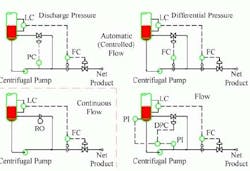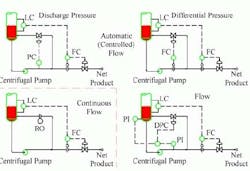Properly protect centrifugal pumps
Low flow can cause overheating, hydraulic instabilities (suction and discharge recirculation) and mechanical unreliability in centrifugal pumps. To prevent such problems, options include both continuous and automatic (active) low-flow protection systems. Figure 1 shows four major types of configurations that provide recirculation back to an upstream feed vessel. Alternatives include recirculation to the pump suction piping.
A continuous system is frequently chosen because of its simplicity. It uses a restriction orifice in a return line. This orifice is typically sized in one of two ways. The more conservative approach selects an orifice for the full minimum flow required. The less conservative one sizes the restriction orifice for a rate that, when added to the minimum expected process flow, gives the minimum flow the pump requires.
Because it operates at all times and the pump needs to have a higher capacity than the process alone requires, a continuous system may impose substantial pump and energy costs. Moreover, its difficult to put into place when the minimum flow is a large fraction of the pumps best-efficiency-point operation. In these situations, recirculation rates and energy costs are high.
Figure 1. Four common options involve recirculation to an upstream feed vessel.
Automatic systems get around this problem. Active flow control systems can use either modulated flow or on/off flow through a control valve. For high-head pumps, a control valve may be placed in series with one or more orifices. The series pressure drops reduce the energy lost at each step and avoid problems of erosion, noise and potential flashing.
In automatic systems, low flow can be detected either by monitoring pump discharge pressure or flow directly.
Discharge pressure measurement is typically cheaper but only suits some situations. To make discharge pressure work, the upstream pressure changes must be small compared to the effect of flow on pump discharge pressure. Using a more-complex differential pressure system across the pump suction can eliminate the effect of upstream pressure changes. Additionally, the discharge pressure curve must always be rising as flow decreases. Discharge pressure control systems work best when the pump curve is relatively steep.
Many pumps have relatively flat curves for discharge pressure versus capacity. So, for these pumps, its better to directly measure pump discharge flow and have a bypass control valve respond as required to maintain minimum flow. While more expensive in the short run, directly measured flow reduces required pump size and minimizes overall operating costs. For most large installations its the most suitable option for low flow protection.
Which method works best depends upon the specifics of your installation. Keep the basic requirements of the pump and how each system works in mind to make the right choice.

